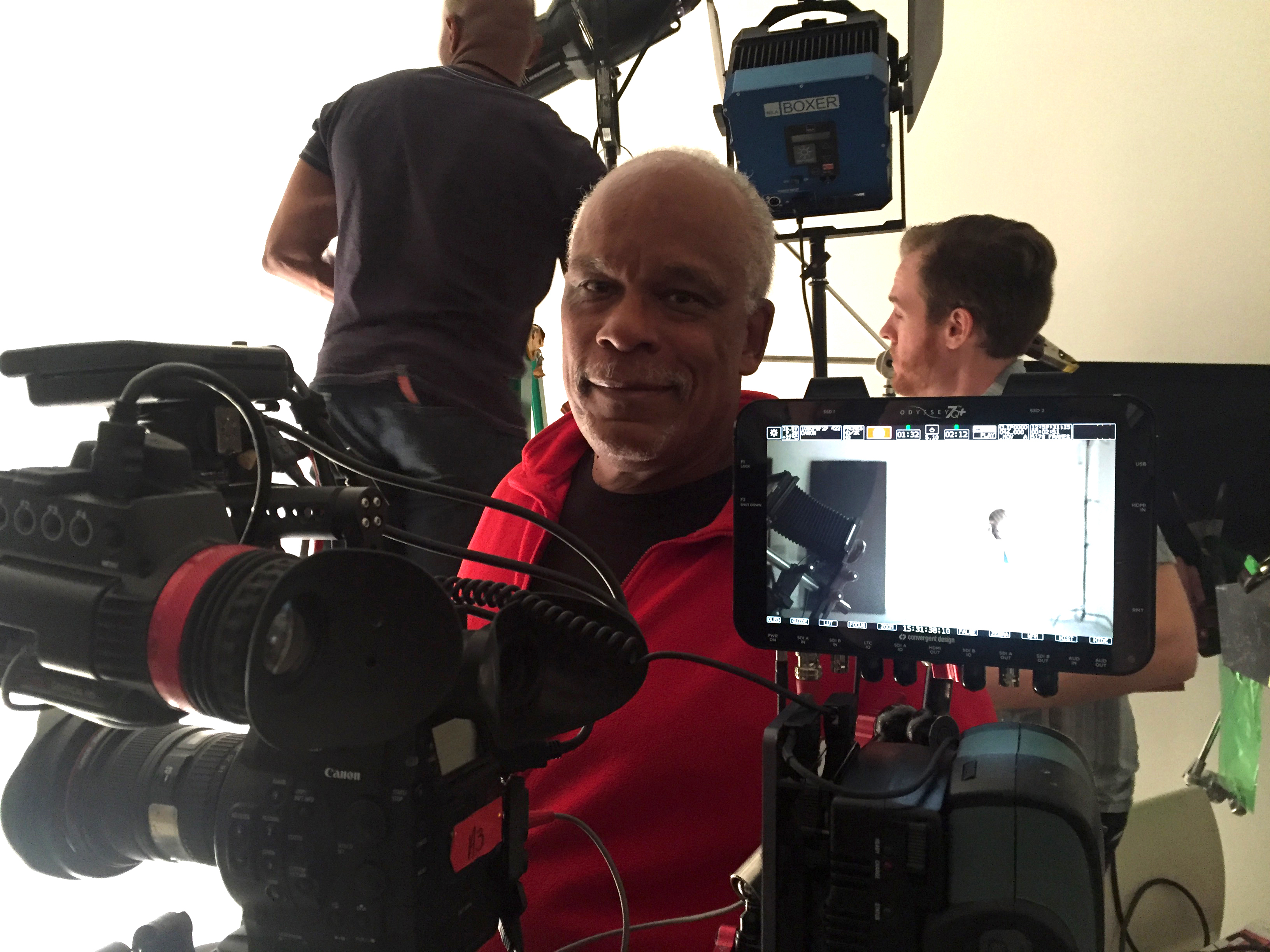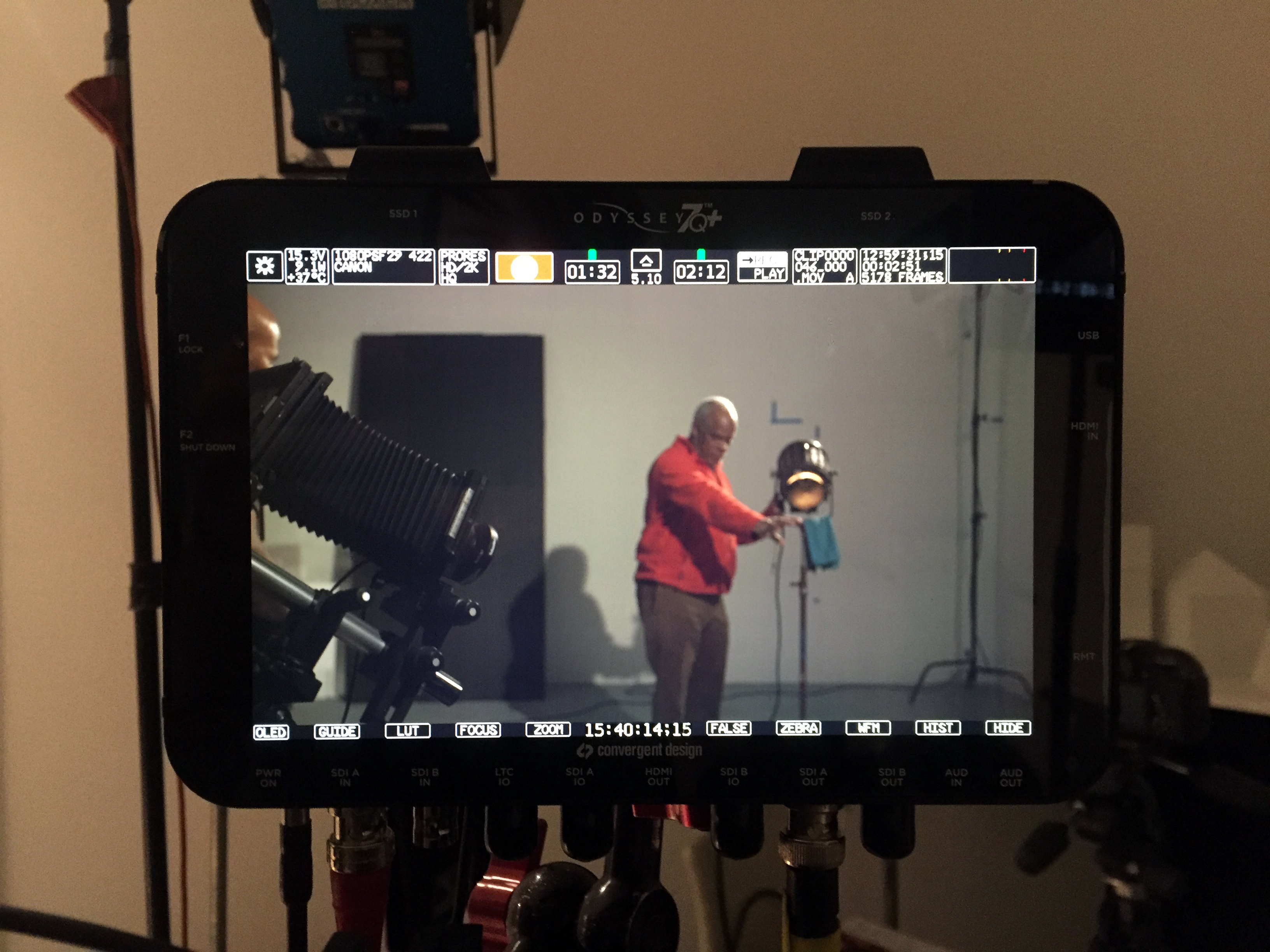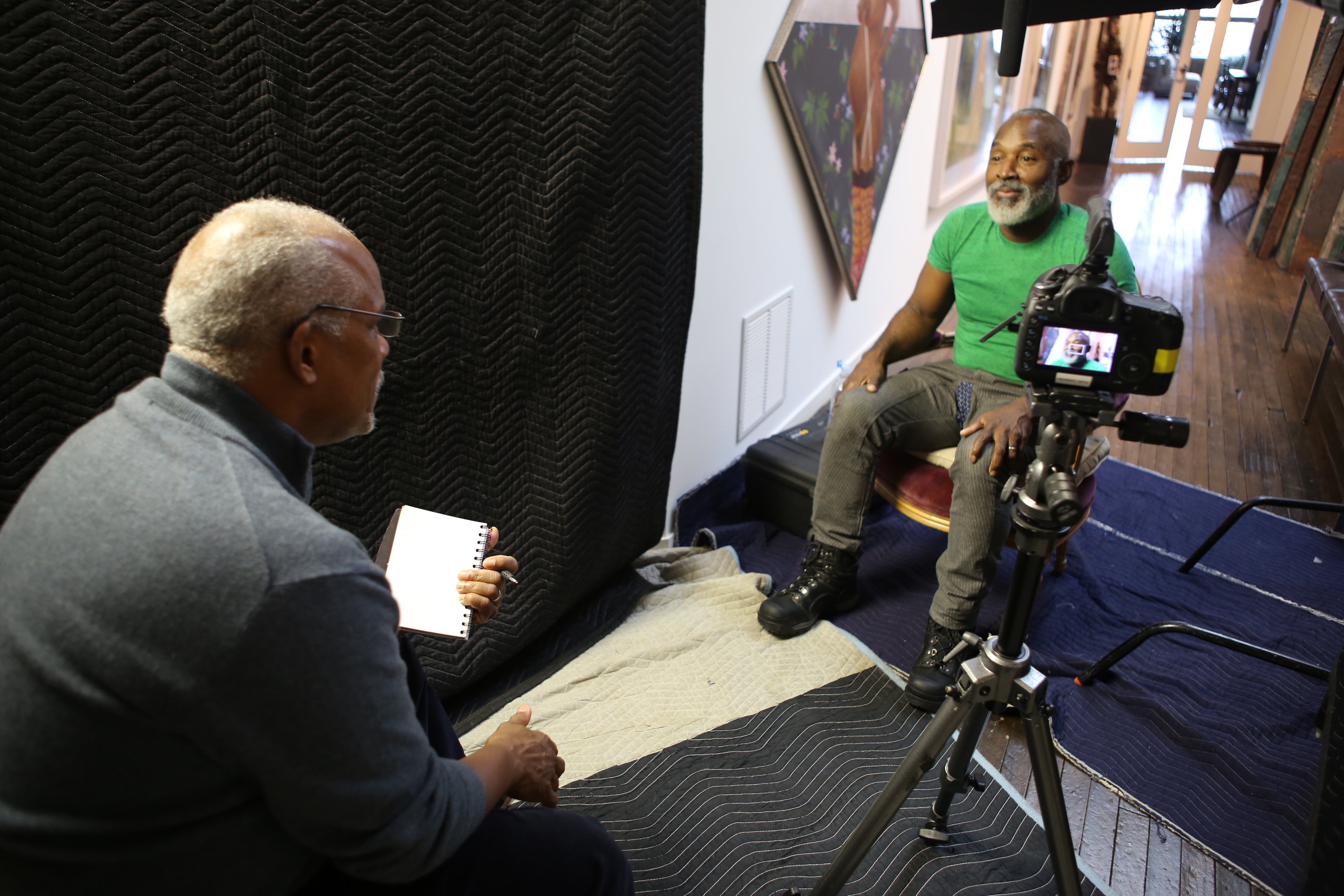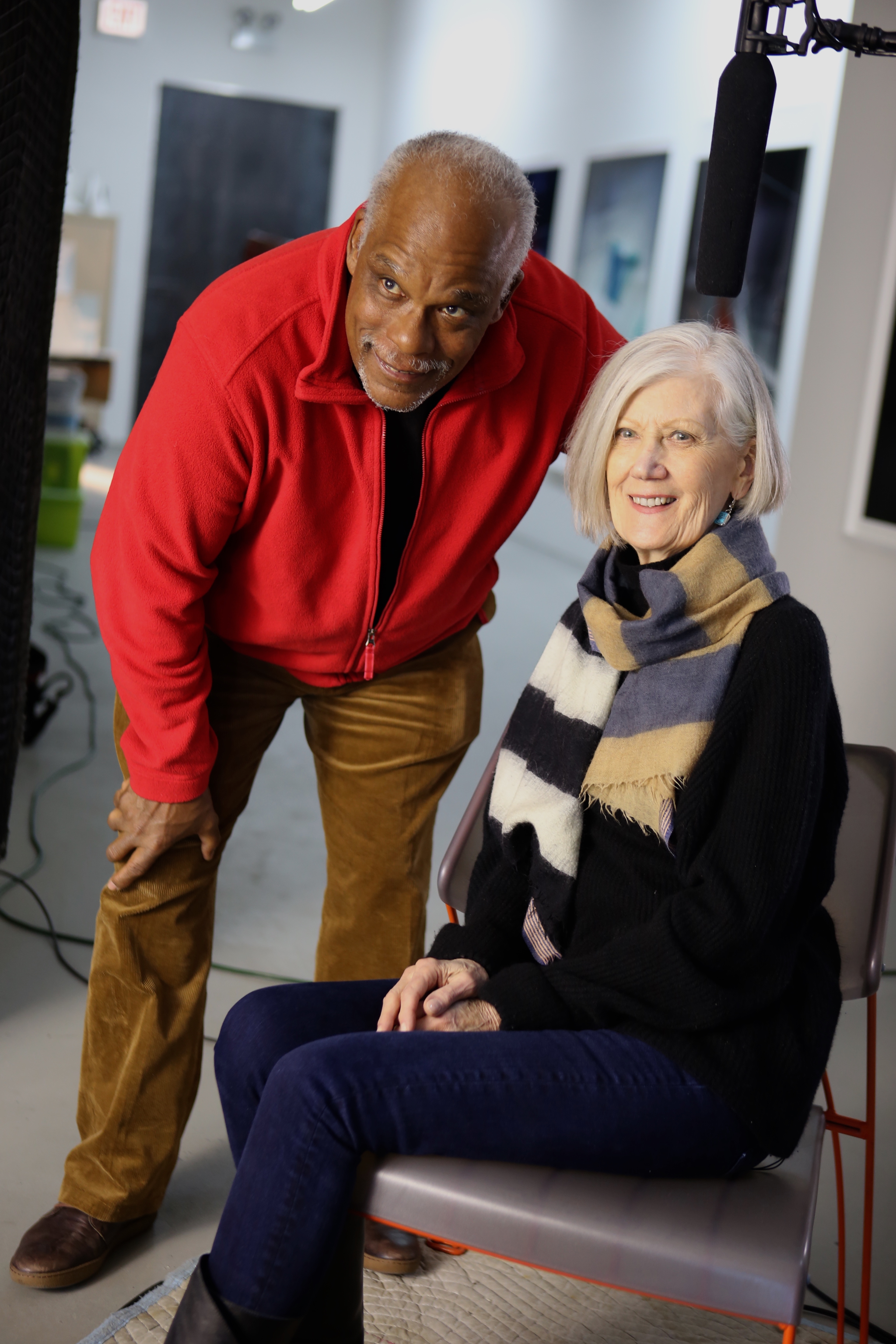
Chicago director Stanley Nelson filming with Barbara Kasten in Chicago, 2016. Behind the scenes of Season 8 of Art in the Twenty-First Century. Photo: Kate Bowen. © ART21, Inc. 2016.
ART21 is thrilled to be working with three new voices behind the scenes in Season 8: directors Deborah Dickson, Pamela Mason Wagner, and Stanley Nelson.
I spoke with Stanley Nelson about his experience directing the Chicago hour in Season 8. A titan in the field of documentary filmmaking, Nelson is a recipient of numerous awards including the Emmy, Peabody, National Humanities Medal, Cine Golden Eagle, and many more, including two MacArthur Genius Grants—one for his work as an individual and one for his production company Firelight Films. Stanley has directed numerous films for PBS including Freedom Riders, The Black Press: Soldiers without Swords, Jonestown: The Life and Death of People’s Temple, and Wounded Knee. His most recent film Black Panthers: Vanguard of the Revolution premiered at the Sundance Film Festival to enormous acclaim, earned record ratings on its PBS broadcast, and continued its festival run during the filming of Season 8–coincidentally bringing Stanley to Chicago for numerous screenings.

Chicago director Stanley Nelson filming with Barbara Kasten in Chicago, 2016. Behind the scenes of Season 8 of Art in the Twenty-First Century. Photo: Kate Bowen. © ART21, Inc. 2016.
Eve Moros Ortega: How did working with artists in Chicago affect how you saw the city?
Stanley Nelson: One of the things about doing an art show is that the artists live in different parts of the city than the areas I already knew. We saw the city through their eyes, so I saw Chicago in a very different way. With Barbara, she was born and raised in Chicago. Chris is in the suburbs, which is very different than the Chicago of tall buildings you expect. Theaster completely transformed his neighborhood. Nick Cave has this incredible live and work space, like a New York loft in Chicago. It was a very different Chicago than I’d ever seen. Also, because we wanted to shoot in different seasons, we were filming in the spring, the winter, and the summer, so I also got a great sense of how Chicago changes throughout the year.
EMO: What was the biggest revelation for you in working on the Chicago hour?
SN: I was surprised at how vibrant the Chicago art scene is, and how people are doing such original work there. All of the artists were very happy to be in Chicago. No one we interviewed wanted to move to New York or LA anytime soon. That was great to see. There are so many different stories—so many different Chicagos.
Each of the artists has such a different relationship to the city, and their artwork and personal stories are so different. It was an amazing process—I learned so much about the artists’ work, and so much in general. I went to an opening at the Studio Museum the other day, and now I look at art differently than when I started.

ART21 filming Nick Cave at his studio, with director Stanley Nelson, in Chicago, 2015. Behind the scenes of ART21’s series Art in the Twenty-First Century, Season 8, 2016. Photo: Keith Walker. © ART21, Inc. 2016.
EMO: Which challenges in shooting Chicago were the hardest? Which were the most exciting?
SN: The challenges came more in the logistics of shooting four artists who are very busy, and are very dedicated to their work. In New York, it’s very easy to jump in and out. For me what was most exciting was the opportunity to work with different artists, to discover their art and get to talk to them. When you go to an art exhibit, you don’t get to talk to an artist. I really enjoyed the relationships we developed, where I could just talk to them about their art, how they make it, why they make it, and how they became artists. The four artists we featured are all very different, but they are all in the middle of very dynamic places in their careers.
EMO: What were the most memorable moments from the film for you?
SN: I love the moments when we see them creating—getting to see their creative process, their spaces, to see where they create, that’s where the magic happens. How do you do this, how does this happen? How does Nick make a ‘soundsuit’? How does Barbara make a photograph? How does Chris make his graphic novels? How does Theaster transform discarded materials into beautiful artworks? To see all of those things with my own eyes, that was most memorable.

ART21 filming Barbara Kasten at her studio, with director Stanley Nelson, in Chicago, 2016. Behind the scenes of ART21’s series Art in the Twenty-First Century, Season 8, 2016. Photo: Keith Walker. © ART21, Inc. 2016.
EMO: Were there any key moments you wished you could have included but left on the cutting room floor?
SN: I don’t think there are any… I think we really got most of the story in there that we wanted to include. I would have loved to have Theaster sing some more. We could have made a whole film about Theaster—it’s hard to grasp the entirety of what he’s doing in the short time we had. For any of the artists, I could easily make a half-hour film! Cutting all the material we shot is hard since there is so much—it’s such a process of refining while not losing scenes that you love, that are important to their stories.
It’s hard to choose a scene that hit the cutting room floor, since all the scenes could have been longer. But they all made it in there, we just had to pare it down to the most essential moments and I think we really succeeded. It might have been nice to get other voices in about the artists, but we would have needed a lot more time to do that, and I know ART21 will do that later with their Exclusive series. The time we have is dominated by the artists’ voices, since that’s how it should be.




Pingback: Stanley Nelson Directs Premiere Episode of ART21 Featuring Chicago Artists Nick Cave and Theaster Gates | Culture Type